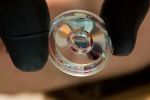Heat Finds Fingerprints Quickly
The CSI teams on TV have all kinds of gadgets, but you won't see anyone at the crime scene reaching for a hairdryer. That could soon be changing thanks to a novel fingerprint imaging technique developed at UTS.
Like many useful scientific discoveries, the new technology has come out of work that originally had a quite different direction.
Two UTS honours students, Adam Brown and Daniel Sommerville, set out to create new reagents that would produce coloured development of fingerprints on paper, but instead uncovered a simpler, safer and more economical method for developing the images.
Current methods for visualising fingerprints on paper are labour intensive and time consuming, using toxic dyes and chemicals to stain the fingerprints or make them fluorescent. The method developed at UTS relies on the application of heat to the sample, with the fingerprint development accomplished in a matter of seconds.
Dr Brian Reedy, a senior lecturer and member of the Centre for Forensic Science in the Faculty of Science, got involved when Adam and Daniel approached him, Dr Ron Shimmon, and Dr Mark Tahtouh, a recent PhD graduate, for advice.
"This was an interesting approach as originally the aim was to make fingerprints coloured using chemicals, but the students noticed that the application of heat alone could actually develop fingerprints," Dr Reedy said.
"An extensive literature survey and discussions with other researchers revealed that there had been little research done regarding the application of heat to fingerprints as it had been considered impractical and inferior to other techniques.
"Our team refined the thermal technique, exposing fingerprints to hot air with temperatures of up to 300 degrees Celsius for periods of 10 to 20 seconds, which produced well-defined images. We also observed that after shorter heating times, fluorescent prints could be observed."
Dr Reedy believes this technology could lead to changes in how fingerprints are collected. “By removing the need for dyes and chemicals, this method makes fingerprint development on paper-based materials much easier and safer, and importantly the images are available much more quickly.
"This technology is also particularly promising as there is the potential to make portable fingerprint imaging devices, which could be used directly at the crime scene. There is also the scope for higher volumes of documents to be treated, something which usually doesn't occur with more time-consuming or expensive methods."
Story from ScienceAlert.com.au
1 Comment
Popular Tags
SciTech
Regular Features
Popular on Popsci
Most Viewed
Most Commented
SciTech
- Sorry Ladies, Those Shots Aren't Sexy
- The Agony of the Heat
- Does Your Taste in Music Reflect Your Intelligence?
- Can People Safely Eat Cat Food?
- Drinking Adds to Cancer Risk
- Sound Becomes Light
- Organ Donors Should Mention It
- Heat Finds Fingerprints Quickly
- Audience Gender Sways Choice
- How to Hit Better Returns in Tennis
Most Emailed
SciTech
- Power From The People
- Who Protects The Internet?
- 3-D Gaming: Real, or Really Lame?
- Flight School
- Sex, Hygiene, and Gardening
- Diet May Explain Cancer Rates
- Internet Explorer 8 Released by Microsoft
- Mercury In-Line Skates Let You Glide On a Shock-Absorbed Cushion Of Air
- The Science Behind Unseen Phenomena
- She Wore Green Setae









Comments
CSI seems to be becoming more of a reality nowdays, despite how much experts do to distance their work from what goes on TV. And with accidental discoveries like this happening, who knows what may be discovered next, or when crime scene investigation comes down to simply swiping an instrument over an area to get everything required.
0 out of 0 people found this comment helpful